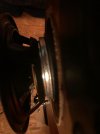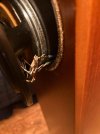SwA.
Member
I recently bought a pair of 2nd hand Totem Arro’s.
In one, and only one, of the speakers, I hear a buzz, clearly coming from the lower speaker (not the upper tweeter). I switched the cables, so even if I switch the left & right channel, it is the same speaker which has a problem. It is not the cable (or any of the equipment upstream) that seems to cause the problem. The buzz is very noticeable in the lower bass frequencies (40-60Hz), e.g. when a double bass is playing.
While auditioning the speakers during the twenty minutes or so I listened to them at the private vendors place, I did not notice the buzz. I did play some music with pronounced bass (e.g. ‘Mi Corazon’ by Brandt, Brauer & Frick).
At home, it was only after a couple of days that I started noticing the buzz. And now, I can’t bear it anymore.
Now, my question:
But, to be more sure, in your opinion, is option (b) possible? Given the 2x300w (at 4ohm) of my power amp… which might be too much for the Arro’s.
How loud did I play? In general, the volume knob of the Freya was between 10 & 12 o’clock, but during a couple of (long) evenings it was between 1 & 3 o'clock. Sound levels never exceeded approximately 85dB (at a distance of 2 meters). At this level, the ‘good Arro’, still played a very clean sound.
I want to have the Arro repaired (or I will try to find another pair) since I am super happy with their sound. But I am trying to figure out whether I need to replace my power amp before using the Arro’s again.
I am not familiar with the technicalities of audio equipment, so I hope to get some competent advice of someone who is.
In one, and only one, of the speakers, I hear a buzz, clearly coming from the lower speaker (not the upper tweeter). I switched the cables, so even if I switch the left & right channel, it is the same speaker which has a problem. It is not the cable (or any of the equipment upstream) that seems to cause the problem. The buzz is very noticeable in the lower bass frequencies (40-60Hz), e.g. when a double bass is playing.
While auditioning the speakers during the twenty minutes or so I listened to them at the private vendors place, I did not notice the buzz. I did play some music with pronounced bass (e.g. ‘Mi Corazon’ by Brandt, Brauer & Frick).
At home, it was only after a couple of days that I started noticing the buzz. And now, I can’t bear it anymore.
Now, my question:
- Option (a): The buzz was already there when I bought the Arro’s, but I did not notice it at first.
- Option (b): I damaged one of the Arro’s myself with my pre/poweramp combination.
- DAC: Topping D70s, xlr out, output volume 5v (if I am not mistaking)
- Preamp: Shiit Freya+ in tube mode (4x Tung-Sol 6SN7GTB), using balanced in- & outputs.
- Power Amp DIY Hypex Nilai 2x256w at 8Ω, 2x300w at 4Ω, power amp set at low gain (12dB)
- Speakers: 2nd hand Totem Arro, impedance 4 Ω, recommended power 20-80w, sensitivity 87dB
But, to be more sure, in your opinion, is option (b) possible? Given the 2x300w (at 4ohm) of my power amp… which might be too much for the Arro’s.
How loud did I play? In general, the volume knob of the Freya was between 10 & 12 o’clock, but during a couple of (long) evenings it was between 1 & 3 o'clock. Sound levels never exceeded approximately 85dB (at a distance of 2 meters). At this level, the ‘good Arro’, still played a very clean sound.
I want to have the Arro repaired (or I will try to find another pair) since I am super happy with their sound. But I am trying to figure out whether I need to replace my power amp before using the Arro’s again.
I am not familiar with the technicalities of audio equipment, so I hope to get some competent advice of someone who is.
Attachments
Last edited:



